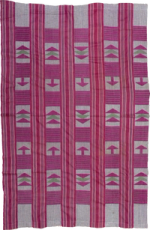Prestige Cloth (Aṣọ-òkè)
UNKNOWN ARTIST
Yale University Art Gallery
New Haven, US
19th century
To craft this opulent garment, a skilled Yorùbá weaver, employing a horizontally oriented, double-heddle loom, meticulously wove ten individual lengths of cloth. These separate pieces were then artfully stitched together, incorporating alternating patterns to achieve a stunning final result. While men took charge of the actual weaving process for aṣọ-òkè, women played an indispensable role in the early stages of production. They actively participated in planting and harvesting cotton, spinning the cotton into fine threads, and subsequently, dyeing and preparing the threads for weaving.
The distinctive motif, executed in silk, features a rectangular shape with an arrow-like projection at one end. This motif gracefully runs across alternating strips and is framed by captivating green and magenta triangles. Interestingly, this design is inspired by the form of a writing board once utilized in Qur’anic schools to teach Arabic. Through this pattern, the rich history of trade and cultural exchange between the Yorùbá and Islamic civilizations is eloquently expressed and celebrated in this remarkable garment.
Type
Textile, Hand-spun cotton and silk (alaari)
172 × 109 cm
